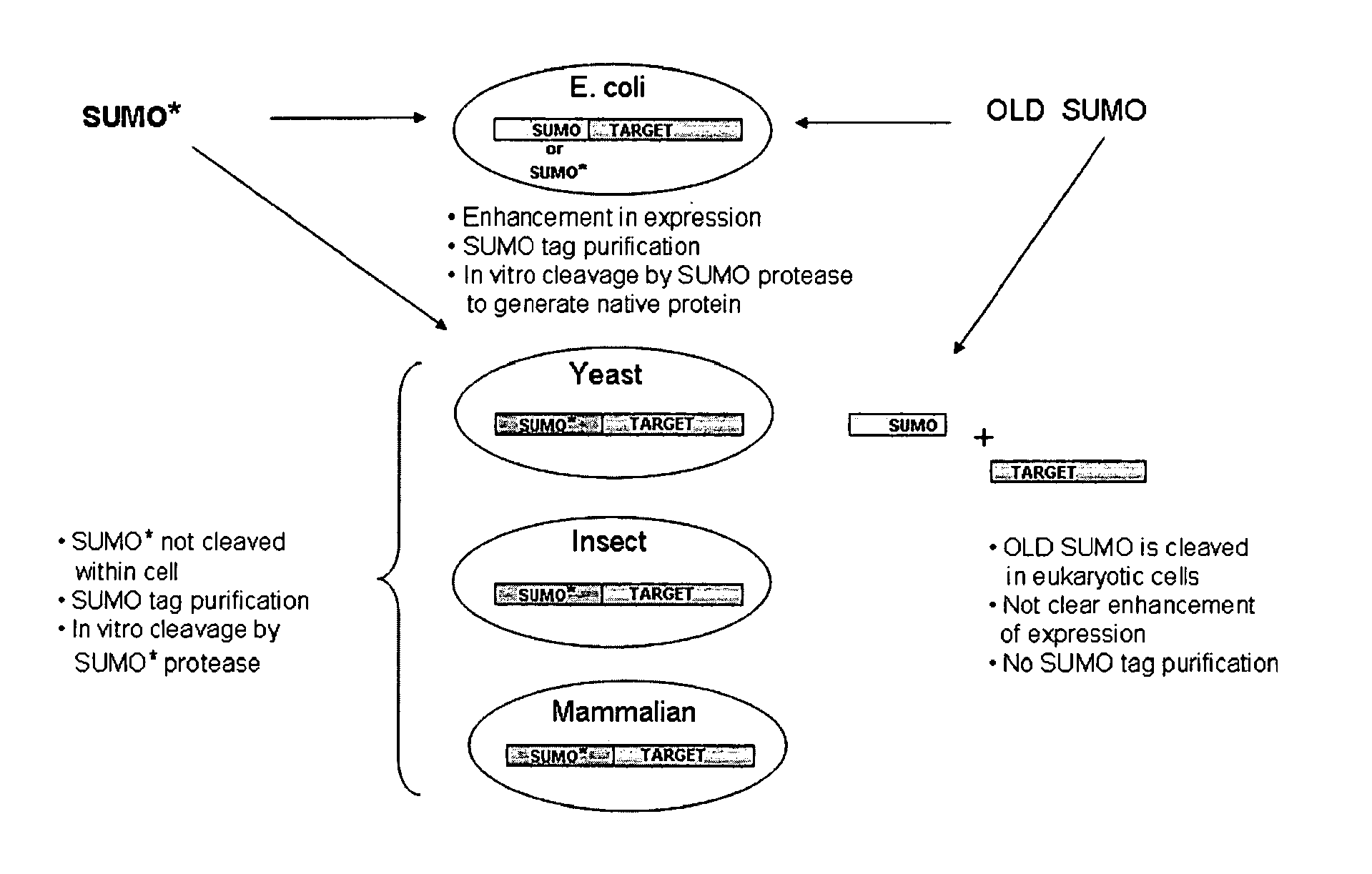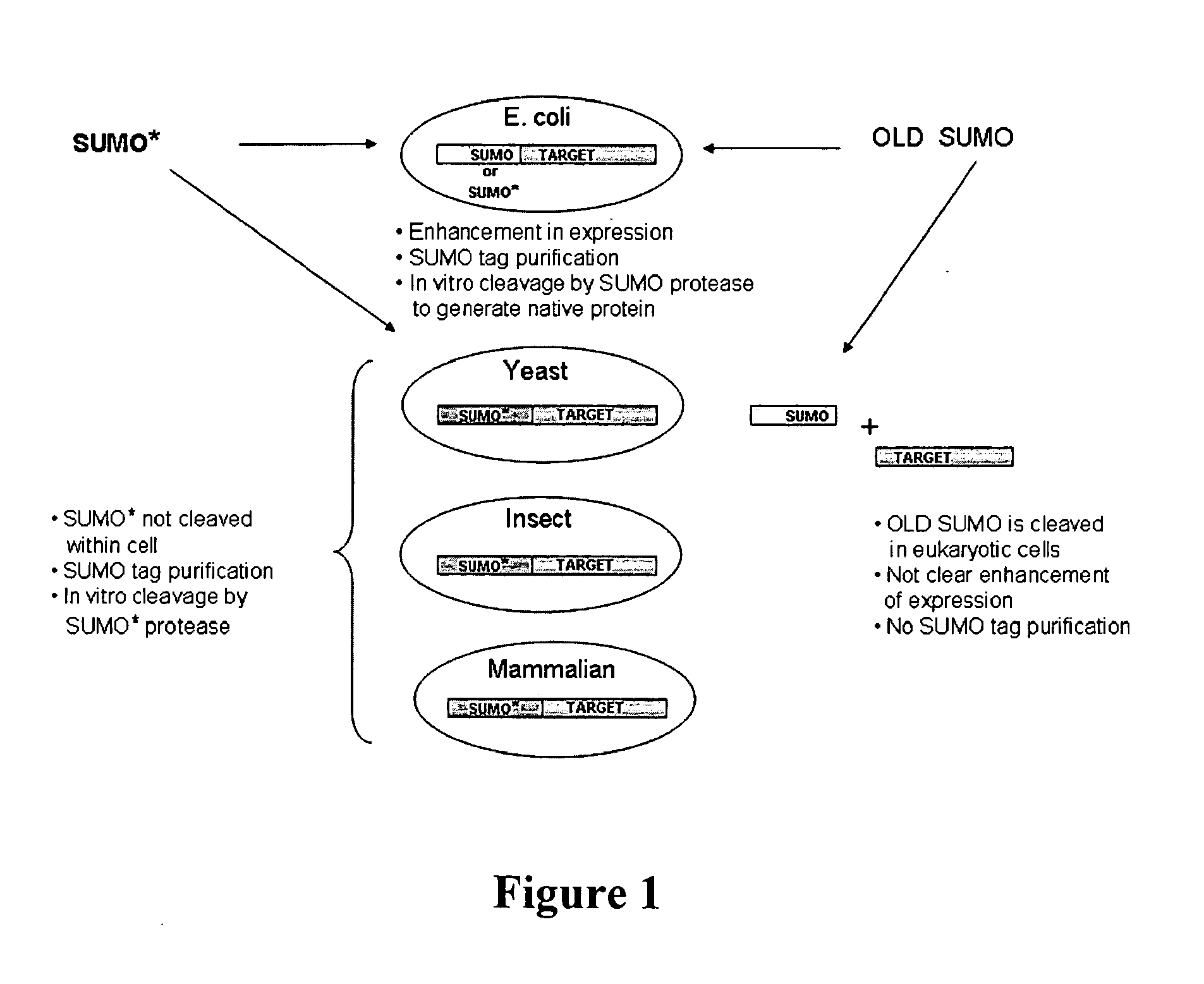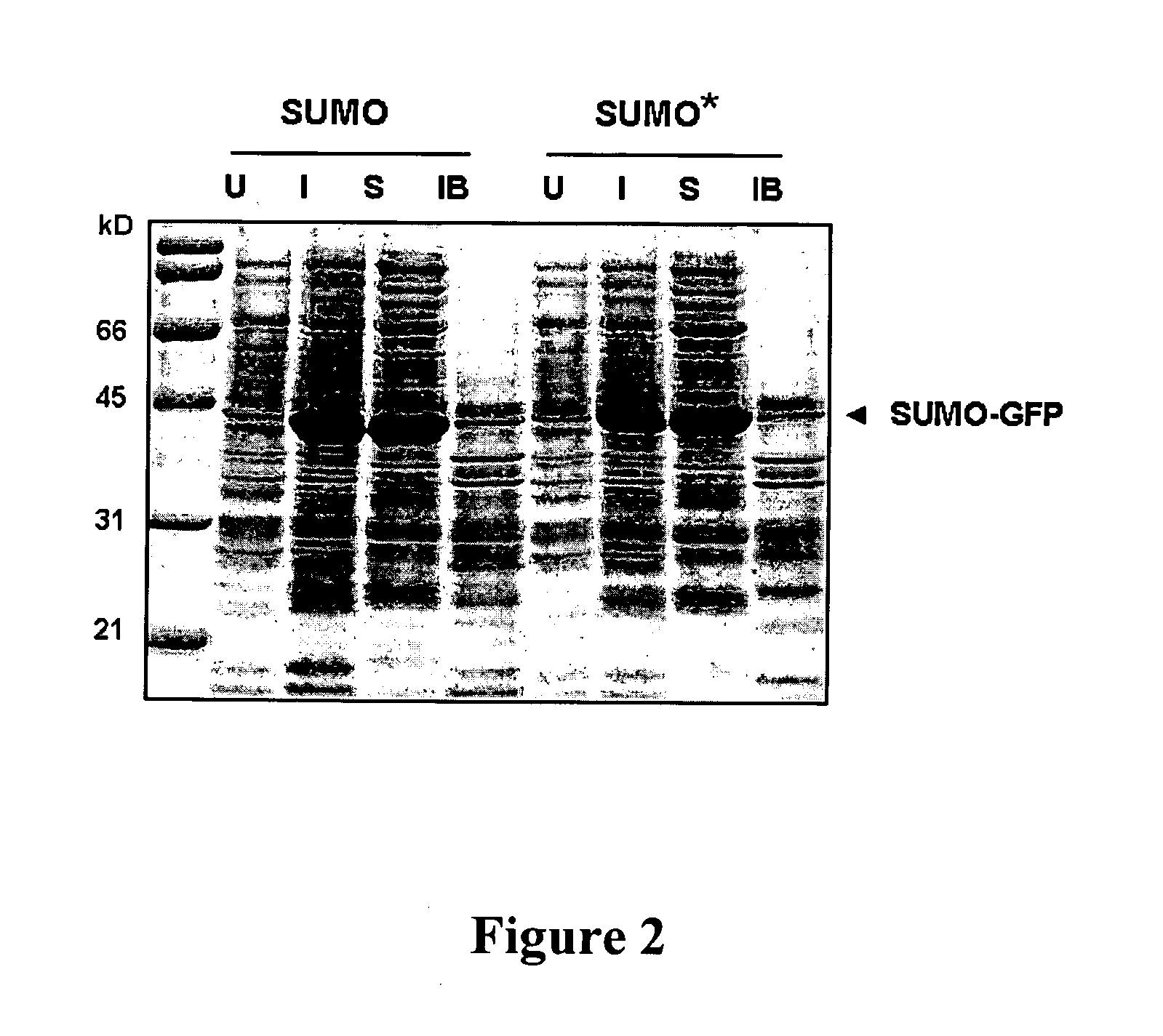Methods and Compositions for Enhanced Protein Expression and Purification
a technology of enhancing protein and purification, applied in the field of recombinant cdna expression and purification of expressed proteins, can solve the problems of heterologous gene products not reaching the correct three-dimensional conformation, inability to uniformly express and purify, and hampered functional genomic studies, so as to increase enhance the secretion of the protein
- Summary
- Abstract
- Description
- Claims
- Application Information
AI Technical Summary
Benefits of technology
Problems solved by technology
Method used
Image
Examples
example i
Materials and Methods
[0117]To co-express SMT3-GFP and ULP1 protease in the same E. coli cell, the T7-SMT3-GFP cassette was amplified from pET24d-Smt3-GFP vector (Malakhov et al. (2004).1. Struct. Funct. Genomics, 5: 75-86) with primers 23 (5′-GGCGCTCGAGTCCCGCGAAATTAATACGACTCA-3′; SEQ ID NO: 7) and 46 (5′-CGCAAAGCTTGAGCTCTTACTTGTACAGCTCGTCCATGCCGA-3′; SEQ ID NO: 8), digested with XhoI and HindIII and inserted into pACYC177 vector (GenBank Accession No. X06402) cut with XhoI and HindIII. This manipulation replaced Kan resistance gene in pACYC177 with SMT3-GFP expression cassette and resulted in the pACYC-SMT3-GFP vector. pACYC-SMT3-GFP was transformed into BL21(DE3) competent cells. The cells carrying pACYC-SMT3-GFP were grown on ampicillin containing media and were made competent using standard CaCl2 method. These competent cells were transformed with another vector carrying ULP1 protease under inducible T7 promoter, pET24-ULP1, described previously (Malakhov et al. (2004) J. Struct....
example ii
[0132]As with wild-type SUMO, engineered SUMOs are capable of increasing the expression of heterologous proteins. Indeed, FIG. 3A demonstrates that GFP is expressed to higher levels in Saccharomyces cerevisiae when the protein is fused to SUMO* as compared to untagged GFP. Additionally, FIG. 13 provides evidence that SUMO* enhances expression of heterologous proteins in insect cells. Specifically, tryptase was cloned into pFastBac vector with either a 6×His tag or SUMO* tag. The fusion proteins were expressed in insect sf9 cells. The Coomassie stained SDS-PAGE gel of the intracellular proteins clearly demonstrates that the enhanced expression of SUMO*-Tryptase as compared to 6×His-tagged tryptase. Notably, the SUMO*-tryptase fusion is not cleaved in insect cells.
[0133]Additionally, engineered SUMOs of the instant invention increase the secretion of heterologous proteins similarly to wild-type SUMO. FIG. 14 is a Western blot of the media proteins from Pichia pastoris expressing Granz...
example iii
[0134]Insect expression vectors were based on pFastBac (Invitrogen, Carlsbad, Calif.) and were made in two steps, similar to Pichia. First, 6×His, SUMO and SUMO* fusion tags were cloned behind the P-polh promoter. Then UBP43, a ubiquitin protease (Liu et al. (1999) Mol. Cell. Biol., 19: 3029-3038), was inserted in frame with the fusion tags into BsmBI-XbaI predigested vectors. Mouse UBP43 was amplified with primers: #265 (CGCGACCTGCATCGAGGTATGGGCAAGGGGTTTGGGCTCCTGAGG; SEQ ID NO: 29) and #266 (CGCGACCTGCATGTCTAGATTAGGATCCAGTCTTCGTGTAAACCAAG; SEQ ID NO: 30), digested with BfuAI. The bacmids were created in DH10bac E. coli cells. After obtaining and titrating the virus, the sf9 cells were transfected and the samples were analyzed for protein production after 72 hours.
[0135]For mammalian expression pcDNA3.1 vector was used. The mouse IgG kappa secretion signal and the three protein tags, 6×His, 6×His-SUMO, and 6×His-SUMO*, were cloned into the HindIII-BamHI sites behind the CMV promoter...
PUM
| Property | Measurement | Unit |
|---|---|---|
| width | aaaaa | aaaaa |
| nucleic acid | aaaaa | aaaaa |
| affinity | aaaaa | aaaaa |
Abstract
Description
Claims
Application Information
 Login to View More
Login to View More - R&D
- Intellectual Property
- Life Sciences
- Materials
- Tech Scout
- Unparalleled Data Quality
- Higher Quality Content
- 60% Fewer Hallucinations
Browse by: Latest US Patents, China's latest patents, Technical Efficacy Thesaurus, Application Domain, Technology Topic, Popular Technical Reports.
© 2025 PatSnap. All rights reserved.Legal|Privacy policy|Modern Slavery Act Transparency Statement|Sitemap|About US| Contact US: help@patsnap.com



